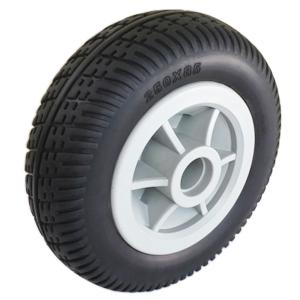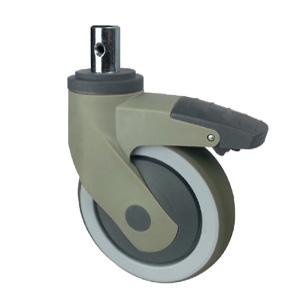Choosing the Right Wheel Bearing for Casters
Rigid casters by HuanXin
When selecting casters, it is important not to overlook the type of bearing used. Both stem and top plate casters require a bearing, which is the component that connects the wheel to the axle. The bearing assembly plays a critical role in the caster’s performance and durability, so it should be carefully considered when choosing the right caster for your application.
Plain Bearing
One of the most common types of bearings for casters is plain. Plain bearings consist of a smooth bearing surface. They don’t contain any balls or rolling elements. Plain bearings are simple and use a basic design consisting entirely of a bearing surface.
Ball Bearings
Certain casters are equipped with ball bearings, which derive their name from the use of small, round balls that roll along a track. Ball bearings are highly effective at minimizing friction and are therefore a popular choice for casters. By reducing friction, ball bearings facilitate smooth and effortless rolling of the caster. This is particularly beneficial as increased friction can hinder the caster’s mobility and make it more difficult to roll. Casters utilizing ball bearings are designed to roll with ease, making them a desirable option for various applications.
Roller Bearings
There are also roller bearings. Many people assume that roller bearings are the same as ball bearings, but this isn’t the case. Ball bearings contain spherical balls, whereas roller bearings contain cylindrical rollers.
Ball bearings are better suited for light loads. If you’re planning to use a set of casters on a heavy object, you should go with roller bearings. The cylindrical rollers can accommodate heavier loads.
Sintered Iron
Sintered iron bearings are a type of bearing characterized by their powder-coated design. Sintered iron is created by coating iron with small powder particles through a process known as sintering. This coating acts as a protective layer, shielding the iron from corrosion and other forms of damage. The powder particles fuse together during sintering to form a protective shell over the iron, preventing moisture and contaminants from reaching the surface. This makes sintered iron bearings a durable and long-lasting option for use in casters and other applications.
Sintered iron bearings are made of sintered iron. They are also oil-impregnated. The oil creates a smoother bearing surface by reducing friction.
In Conclusion
Not all casters feature the same type of bearing. Casters consist of undriven wheels with a frame, and they are designed for use on the bottom of an object. Some of them have a different type of bearing for the wheel than others. There are plain bearings, ball bearings, roller bearings and sintered iron bearings.

The Beginner’s Guide to Pneumatic Casters
Pneumatic casters by HuanXin
Pneumatic casters have emerged as a popular alternative to traditional casters and are worth considering when shopping for casters. Unlike traditional casters, pneumatic casters operate on air pressure and are designed to absorb shock, providing protection to the objects they are used with. Pneumatic casters are effective at minimizing damage, making them a suitable choice for delicate or fragile objects. Understanding how pneumatic casters work and their benefits can help you determine if they are the right choice for your application.
What Are Pneumatic Casters?
Pneumatic casters are casters that feature air-filled wheels. The term “pneumatic” means “operating under air or pressure.” Pneumatic casters are characterized by their use of air-filled wheels.
All casters are equipped with wheels, which are unpowered and designed for use on the bottom of an object. Casters can be installed on a variety of objects, including chairs, carts, machines, and workbenches. Depending on the application, casters may feature solid or hollow wheels. Pneumatic casters, in particular, are characterized by their hollow wheels, which are filled with air. This air-filled design enables pneumatic casters to absorb shock and reduce impact, making them ideal for use with delicate or fragile objects.
How Pneumatic Casters Work
Pneumatic casters work like most other casters. Each pneumatic caster consists of an air-filled wheel that’s attached to a frame. The wheels themselves are made of a rubber polymer, whereas the frames are made of a metal or alloy.
To install casters, the mounting frame must be attached to the bottom of an object using four or more threaded holes. Bolts are driven through these holes and into the bottom of the object to secure the frame in place. When installing pneumatic casters, the process is the same, with the only difference being the type of wheels used. Pneumatic casters have air-filled wheels that are attached to the mounting frame, allowing for shock absorption and impact reduction. Once the casters have been securely mounted to the object, the object can then be easily rolled around.
Benefits of Pneumatic Casters
Pneumatic casters offer excellent shock-resistant properties. They will absorb the shock of the ground or floor naturally as they roll. Other types of casters offer little or no protection against shock. Casters that feature solid wheels are durable, but they aren’t able to absorb shock.
If you’re planning to roll them on rough or uneven surfaces, you may want to choose pneumatic casters for this reason. With their air-filled tires, they can absorb shock. They’ll absorb the shock of the ground or floor, thus stabilizing the objects to which they are mounted. The end result is a smoother rolling operation that protects the objects from damage.
In addition to their shock-absorbing properties, pneumatic casters provide the added benefit of quiet operation. They are nearly silent, making them an ideal choice for indoor rolling applications where noise levels need to be kept to a minimum. Hospitals and other commercial buildings often use pneumatic casters on equipment for this reason. The air-filled tires of pneumatic casters enable them to roll smoothly and quietly, providing a convenient and efficient solution for moving objects around without disturbing the surrounding environment.

How to Prevent Caster Flutter
Casters by HuanXin Engineering
Casters offer an unparalleled level of convenience when compared to traditional wheels. Consisting of wheels attached to or embedded inside of a frame, they are used to move objects. You can find casters on chairs, furniture, medical equipment and even machines. While convenient and easy to use, though, some casters may experience a problem known as caster flutter.
What Is Caster Flutter?
Caster flutter is a problem that occurs when a caster spins perpendicularly to the direction in which it is being pushed. Ideally, when pushing an object forward, the casters should roll forward in the same direction. However, caster flutter can cause the casters to spin side to side, making it difficult to move the object or even causing it to tip over. Fortunately, there are ways to prevent caster flutter.
Choose High-Quality Casters
High-quality casters are less likely to experience this phenomenon than their low-quality counterparts. Casters shouldn’t flutter if they are properly designed. Fluttering is a sign of poor craftsmanship. When properly designed, casters should roll smoothly in the direction in which they are pushed. If you’re worried about caster flutter, choose high-quality casters from a reputable manufacturer.
Keep in mind that the weight of a caster will affect its risk of fluttering. Heavy casters are less likely to flutter than lightweight casters. As a result, you may want to choose casters made of a heavy and solid material to prevent them from fluttering.
Lubricate
One effective way to prevent caster flutter is through proper lubrication. Casters with an enclosed frame can be particularly susceptible to fluttering if they are not adequately lubricated. Without proper lubrication, friction between the wheels and the frame can cause the casters to spin side to side instead of rolling smoothly in the intended direction. Applying a small amount of lubricant to the frame can help reduce friction and allow the casters to roll smoothly, minimizing the risk of caster flutter.
Clean Regularly
Don’t forget to clean your casters regularly. Casters can attract dirt and debris. After all, they roll on the ground — and there’s typically a lot of dirt and debris on the ground. Failure to clean your casters may result in the buildup of dirt and debris to the point where they no longer roll smoothly. Instead of rolling smoothly in the same direction in which they are pushed, they may flutter side to side. You can prevent this from happening by cleaning your casters regularly.

